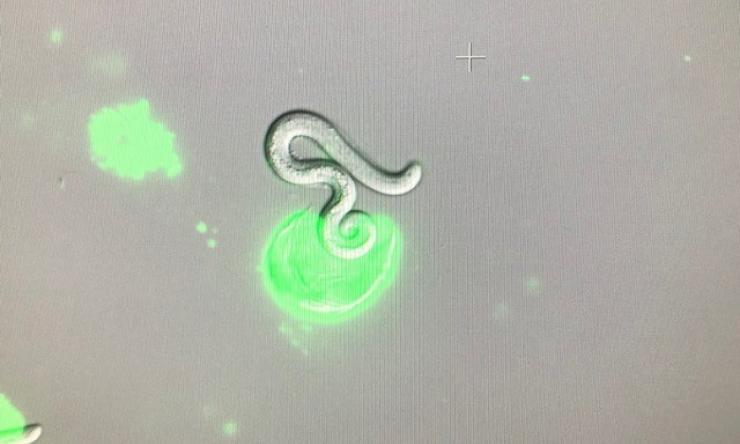
Laboratory Director
Jill Weatherhead, M.D., Ph.D., CTropMed, FAAP

Associate Laboratory Director
Yifan Wu, M.D., Ph.D.
About the Lab
The Laboratory of Immunoparasitology is a basic science and translational lab focused on understanding the complex relationship between infections, specifically infections of poverty, and the host immune response. The lab has a particular focus on infections that have devastating long-term impact on the health of children. Helminths are infectious parasites and infections of poverty that disproportionately infect children living in resource-limited regions globally. Using animals models, cell cultures, sophisticated immunologic assays and physiologic monitoring, the lab aims to understand the innate and adaptive host immune responses during infection to discover novel interventional targets. These targets will be used for the design and development of preventive and therapeutic drugs and vaccines as well as diagnostic immunoassays that are critically needed to improve the health of millions of children particularly those living in parasite endemic communities.
Current activities include the following research projects:
Helminth Larval Migration Induces Chronic Disease
Ascariasis (roundworm) is the most prevalent helminth infection in the world. Beyond the intestinal form of ascariasis, little is known about the impact of Ascaris larval migration through lung tissue. Following oral ingestion of Ascaris eggs, ascariasis has been linked to a transient allergic airway disease termed Loeffler’s Syndrome and some clinical studies have suggested larval stage ascariasis may represent a major environmental cause of allergic airway disease, or asthma, in resource-poor regions. Animal studies exploring how the host immune response is linked to larval migration and development of Ascaris-induced allergic airway disease and other chronic lung diseases are required for the identification of novel interventional targets. Our lab has developed a working mouse model of Ascaris-induced allergic airway disease and chronic lung disease. The work in our lab shows that Ascaris exhibits all of the defining phenotypes of clinical asthma and establishes a mouse model in which the pathophysiology of Ascaris-induced allergic airway disease can be studied at a molecular level. Furthermore, we have found that a single Ascaris infection can lead to long-term lung damage manifesting clinically as emphysematous-like disease and chronic anemia in animal models.
Related Publications
Weatherhead JE, Gazzinelli-Guimaraes P, Knight JM, Fujiwara R, Hotez PJ, Bottazzi ME, Corry DB. Host Immunity and Inflammation to Pulmonary Helminth Infections. Front Immunol. 2020 Oct 20;11:594520. doi: 10.3389/fimmu.2020.594520. PMID: 33193446; PMCID: PMC7606285.
Weatherhead JE, Porter P, Coffey A, Haydel D, Versteeg L, Zhan B, Gazzinelli Guimarães AC, Fujiwara R, Jaramillo AM, Bottazzi ME, Hotez PJ, Corry DB, Beaumier CM. Ascaris Larval Infection and Lung Invasion Directly Induce Severe Allergic Airway Disease in Mice. Infect Immun. 2018 Nov 20;86(12):e00533-18. doi: 10.1128/IAI.00533-18. PMID: 30249744; PMCID: PMC6246907.
Wu Y, Li E, Knight M, Adeniyi-Ipadeola G, Song LZ, Burns AR, Gazzinelli-Guimaraes AC, Fujiwara R, Bottazzi ME, Weatherhead JE. Transient Ascaris suum larval migration induces intractable chronic pulmonary disease and anemia in mice. PLoS Negl Trop Dis. 2021 Dec 16;15(12):e0010050. doi: 10.1371/journal.pntd.0010050. PMID: 34914687; PMCID: PMC8717995.
Early Helminth Larval Invasion of Gastrointestinal Track
Following ingestion of Ascaris eggs which are typically ubiquitous in the environment of endemic regions, third-stage, infectious larvae hatch from the egg and translocate across the gastrointestinal epithelium. Our lab is investigating the mechanism by which early Ascaris larvae are able to penetrate the gastrointestinal mucosa and cause chronic gastrointestinal damage. We made the paradigm-shifting discovery that Ascaris eggs utilize the gastric microenvironment to facilitate Ascaris larval hatching. Furthermore, repeated Ascaris infection causes significant gastric mucosa damage leading to cellular reprogramming of the gastric microenvironment and ultimately reduction in Ascaris hatching and infection on subsequent challenges.
Related Publications
Wu, Y, G Adeniyi-Ipadeola, M Adkins-Threats, M Seasock, Suarez-Reyes, R Fujiwara, ME Bottazzi, L Song, JC Mills, JE Weatherhead. Host gastric corpus microenvironment facilitates Ascaris suum larval hatching and infection in a murine model. PLoS Neil Trop Dis. 2024. 18(2): e0011930. doi: 10.1371/journal.pntd.0011930. PMCID: PMC10878500 PMID: 38324590
Development of Novel Diagnostic Tools for Toxocariasis in Children
Toxocara, the dog and cat roundworm, is the most common zoonotic infection in the United States. Toxocariasis disproportionately infects children living in poverty in the United States and can lead to life-long morbidity including asthma, epilepsy and vision loss. Early diagnosis and treatment can impede larval migration and reduce the risk of developing Toxocara-induced long-term morbidity in children. However, currently available diagnostic assays have limited sensitivity, specificity and scale-up ability. Our lab is using recombinant protein technology to develop novel diagnostic immunoassays to improve diagnosis of toxocariasis in children. Clinical trials in collaboration with the Pediatric Tropical Medicine Clinic at Texas Children’s Hospital to evaluate novel diagnostic immunoassays and to determine test of cure assays are underway.
Related Publications
Fortini, MB, TA Erickson, LM Leining, KM Robinson, MN Carey, SJ Smith, B Sullivan, AR Nelson, SM Gunter, JE Weatherhead. Review of Toxocariasis at a Children's Hospital Prompting Need for Public Health Interventions. Pediatric Infectious Disease Journal. 2023. 42(10): 862-866. doi: 10.1097/INF.0000000000004042. PMID: 37625080. PMCID: PMC10754417
Laboratory Facilities
Our laboratory has dedicated research space in the Texas Children’s Hospital Center for Vaccine Development. We have in house equipment for fluorescent microscopy, real-time PCR, gel imaging and documentation, ELISA, ELISpot, Luminex, flow cytometry, lung physiology (whole body plethysmograph and airway compliance), histopathology and two BSL-2 facilities. The laboratory also collaborates with the adult Tropical Medicine Clinic through Harris Health Systems and the Pediatric Tropical Medicine Clinic through Texas Children’s Hospital for translational (“bench to bedside”) research.

Ascaris hatching
Ascaris (roundworm) hatching from fluorescently stained egg
 Credit
Credit
Ascaris (roundworm) larvae
Fluorescently stained Ascaris Larvae in vitro








